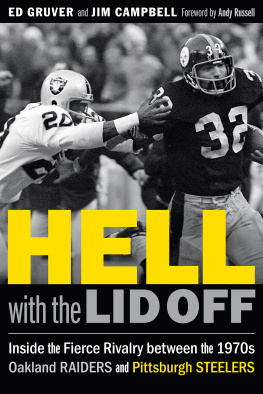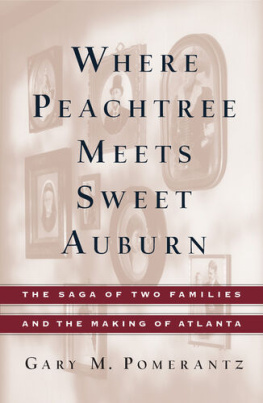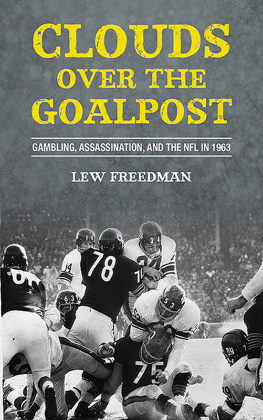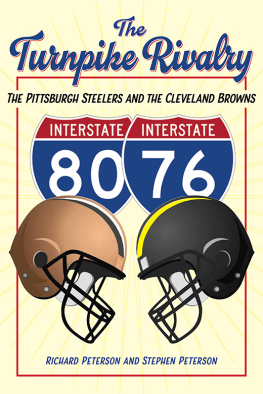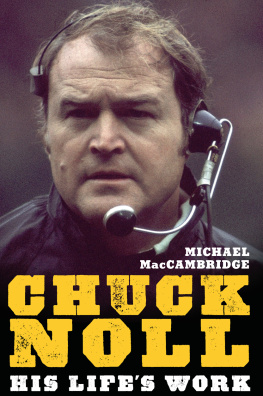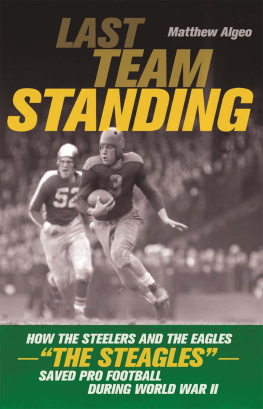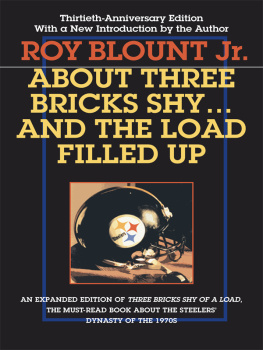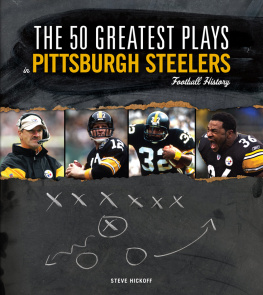THE 63 STEELERS
WRITING SPORTS SERIES
Richard Pete Peterson, Editor
The Cleveland Indians
Franklin Lewis
The Cincinnati Reds
Lee Allen
The Chicago White Sox
Warren Brown
Dreaming Baseball
James T. Farrell
My Greatest Day in Football
Murray Goodman and Leonard Lewin
The Detroit Tigers
Frederick G. Lieb
The Philadelphia Phillies
Frederick G. Lieb
The Washington Senators
Shirley Povich
The 63 Steelers: A Renegade Teams Chase for Glory
Rudy Dicks
THE 63 STEELERS
A RENEGADE TEAMS
CHASE FOR GLORY
RUDY DICKS
THE KENT STATE UNIVERSITY PRESS Kent, Ohio
2012 by The Kent State University Press, Kent, Ohio 44242
All rights reserved
Library of Congress Catalog Card Number 2012013505
ISBN 978-1-60635-143-7
Manufactured in the United States of America
Every effort has been made to obtain permission from those persons
interviewed by the author who are quoted in the book.
LIBRARY OF CONGRESS CATALOGING-IN-PUBLICATION DATA
Dicks, Rudy.
The 63 Steelers : a renegade teams chase for glory / Rudy Dicks.
p. cm. (Writing sports series)
Includes bibliographical references and index.
ISBN 978-1-60635-143-7 (pbk. : alk. paper)
1. Pittsburgh Steelers (Football team)History.
I. Title. II. Title: 1963 Steelers. III. Title: Nineteen sixty three Steelers.
GV956.P57D5 2012
796.332'640974886dc23
2012013505
16 15 14 13 12 5 4 3 2 1
For the 1963 Pittsburgh Steelers
and for Sheldon J. Dicks, who set an example for
how to be as tough as Red Mack,
as compassionate as Art Rooney, and as confident as Bobby Layne
and for Lillian W. Dicks,
for nurturing in her sons
a love for reading and writing
You may glory in a team triumphant, but you fall in love with a team in defeat. Losing after great striving is the story of man, who was born to sorrow, whose sweetest songs tell of saddest thought, and who, if he is a hero, does nothing in life as becomingly as leaving it.
Roger Kahn, The Boys of Summer
The noblest battles of all are those fought in vain.
Edmond Rostand, Cyrano de Bergerac
CONTENTS
PREFACE
I grew up in the late fifties and early sixties in a ranch-style house at the corner of Rosewae Drive and Skywae Drive in a city that the Saturday Evening Post labeled Crime Town USA and that also came to be known as Murder Town.
Some days my mother would hide the front section of our hometown paper, the Youngstown Vindicator, so that my brothers and I would not be exposed to the gory headlines and stories about guys with funny nicknames getting blown up in cars and their body parts being scattered across the neighbors yard. I didnt find out about her protectiveness until years later, but I wouldnt have minded anyway, as long as she didnt take away the sports section. The only bombs I cared about as a kid were the ones quarterbacks threw.
That 63 Post story said that there had been seventy-five bombings in Youngstown over a decades time, which, if accurate, means that the only person busier than the wise guys in town was my mother stashing away sections of the afternoon paper. But the world of Cadillac Charlie, the Crab, Tar Baby, and the bug (the numbers game) was far from ours in northeast Ohio. My view from the crest of the hill on Rosewae was filled with more innocence than Lake Wobegon: dads mowing the lawn, moms working in the garden, kids riding bikes, and the fireworks in the distance from Idora Park, where my dad would take my mom on Sunday nights in the summer to listen and dance to Stan Kenton, Buddy Rich, and Woody Herman. You could phone us by dialing SWeetbriar 23065 or send us a letter using a new number introduced in the summer of 63, something called a zip code, which replaced our old postal code, number 11.
There were much scarier places, I knew, such as the Deep South, Europe, and Africa, because I had seen them up close, bigger than life, when my dad took us downtown to the Palace, Paramount, and Warner theaters, which showed To Kill a Mockingbird, The Guns of Navarone, and Lawrence of Arabia. Good thing, I told myself, that we lived someplace safe.
The next-door neighbors had a son in high school who played catch with me, coaxed me to show off my basketball-dribbling skills in front of his friend, and one afternoon tried to teach me to play the guitar. Because of his hairstyle, he reminded me of Edd Kookie Byrnes from 77 Sunset Strip, and I was sure that he owned a black leather jacket; maybe he even snuck Marlboro cigarettes like they showed on TV ads. After our family moved away a few years later, I turned on my transistor radio one morning and heard his voice booming out, singing the Isley Brothers Nobody But Me. It was Dick Belley, and for nearly half a century his version would remain as popular as it was in 67. Music fans remember Dick Belley as a member of the Human Beinz, who played at Idora Park regularly, but I remember him as a decent older boy who took the time to befriend a kid.
We played Wiffle ball in the backyard, and kickball and kick-the-can in a cul-de-sac, and we loaded kids into our station wagon to go to the drive-in with a cooler full of pop, but my favorite spot of all was the one right in front of me every time I stepped out the front door: a stretch of green lawn that looked as lush to me as any fairway at Augusta would to a golf fan. It was the biggest yard in the neighborhood, and the best for tackle football, and it was where the neighborhood kids always played.
When we werent playing football, we were watching it on TV. Growing up in Youngstown, what was more intimidating than any mobsters was being a Pittsburgh Steelers fan and finding yourself outnumbered by Cleveland Browns fans. Youngstowns equidistant location between Cleveland and Pittsburgh was convenient for the mobs itinerary, but it didnt mean loyalties were divided equally between the teams. Even I started out, tentatively, as a Browns fan. Without cable TV, the Internet, or Monday Night Football, my exposure to other teams was limited to the daily newspaper and football magazines.
One late November Sunday morning when I was seven, I asked my dad if we would be rooting for the Browns that afternoon. My father was born and raised on the Iron Range in Minnesota, so he had more allegiance to the University of Minnesota, Bronislau Bronko Nagurski, and the Duluth Eskimos barnstorming team than he did to the Browns. He paused and then told me about the man who played quarterback for the Steelers, the Browns opponent that day. His name is Bobby Layne, my dad said, and he believes he can do anything.
I wasnt convinced, especially considering the Browns were 62 and the Steelers 341, and my doubts were justified as Cleveland clung to a 2014 lead in the final minutes. But then the man who would be dubbed Last-Minute Layne in the Pittsburgh Post-Gazette the next day began working his two-minute magic as my dad and I watched on our black-and-white TV. Two pass completions, a penalty, and a run put the Steelers on the Browns 17, and with only forty seconds left, Layne hit Gern Nagler under the goalpost with a touchdown pass.
Pennsylvania governor David L. Lawrence was the preeminent fan among the estimated 10,000 Steelers diehards who made the three-hour trip from Pittsburgh to Municipal Stadium on the shores of Lake Erie, and his reaction was duly noted by the


